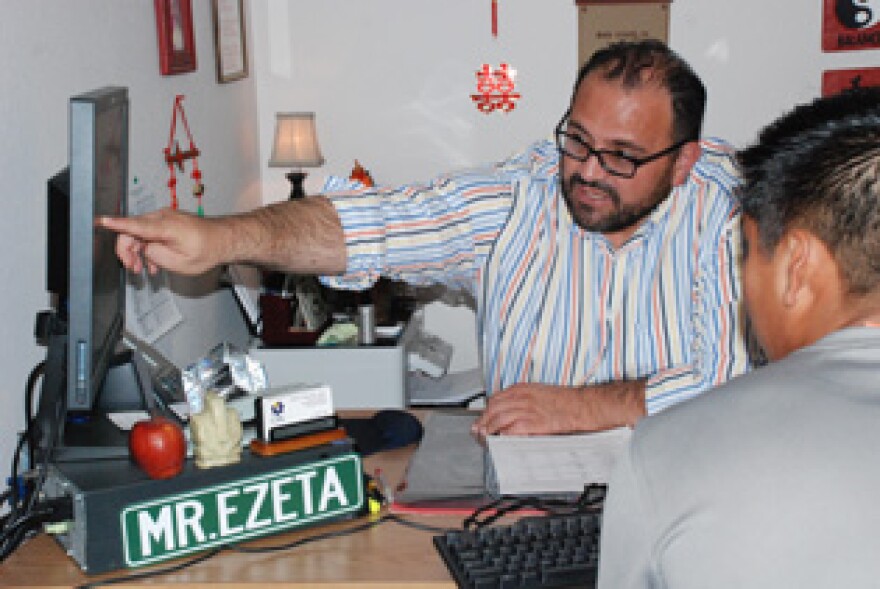BY KATE SHEEHY -- More and more Latinos are going to college. A recent study from the Pew Hispanic Center shows that, for the first time, Latinos have surpassed whites in college enrollment numbers and more than half of these students are enrolled in Community Colleges. One college in Southern Nevada is struggling to meet the needs of its Latino student body.
Carlos Ezeta is an academic counselor in the School of Business and Hospitality at the College of Southern Nevada in Las Vegas. He talks with 21-year-old student Karen Espinoza. She is upset and feels that her three years at CSN may have been wasted.
“Why are you crying?” he asks her.
Espinoza tells him she wants to be an Immigration Lawyer. But she is worried she will never make it out of community college to a university. Espinoza works full-time in an insurance agency. She has been buying her younger sisters clothes, school supplies and taking them out to eat. Ezeta reminds her of how she has helped support her family. He tells her she is the oldest and is setting an example for her sister who is about to start college.
“When she graduates, she’ll say, ‘you showed me how it’s done. You bought my Levis, my back pack.’ You’re doing well,” he tells her. “You’re on the right path, don’t lose your focus.”
Espinoza came to the U.S. as a little girl and is now fluent in English. But she says she still chose Ezeta from a list of counselors because of his Spanish name.
“We just know where we’re coming from, we have something in common. He knows how the struggle is. Not everybody sees that, not even my own parents. I don’t know. I just feel like he’s the right person to guide,” Espinoza said.
Having the right person to guide a student is critical to their success rate. But Ezeta is the only bilingual academic counselor for CSN’s nearly 40 thousand students.
“If you’re a brand new student and an ESL learner, second language acquisition learner or you’re in a nursing program and you want to learn more about that and there’s no one in the school of sciences that speaks Spanish-guess where that student goes? They go to Carlos. If Carlos could be multiplied in ten this school would be different,” Ezeta said.
Schools like CSN are struggling to find the resources to meet the unique needs of their student bodies.
Deborah Santiago is Co-Founder of the Washington, D.C.-based research institution called Excelencia in Education. In a recent study she helped author, she describes the profile of the average Latino student as "post-traditional." She says Latino students, and increasingly all students, differ greatly from the more traditional idea of a college student who is 18-years-old, graduates from high school, goes straight to a four-year university, and gets a degree in four years.
“A high concentration of Latinos would be the first in the family to go to college and I think that’s where looking at community colleges as an affordable option for them is real. So they can get back into the workforce relatively quickly and earn an income and support themselves and their family,” Santiago said.
But Community Colleges across the country have to find ways and funds to keep Latino students in school. Last year, 21 percent of Latinos earned an Associate’s degree or higher compared to 40 percent of all adults.
CSN is among the top five largest Community Colleges in the country. Almost 25 percent of the student body here is Latino – a demographic that puts them in the running to qualify for federal funds designated for so-called Hispanic Serving Institutions.
Clarissa Cota is the chair of the task force at CSN that is making sure the school can qualify for those funds. She says right now the college is failing to graduate Latino students at a high rate.
“Are we servicing all of their needs? No, we’re not. Could we do a better job? Yes, we could,” Cota, said.
The college has fallen behind over the last five years after budget cuts of over $23 million. But this year, they’ll get a small boost of nearly five million dollars. Cota says some of that money will be put towards preparing their Latino students.
“We need to get them to be college literate, being aware of what financial aid opportunities they may have, how do you actually register for classes, what’s a proper major for them to be choosing, what’s a proper first semester load,” she said.
But qualifying for federal subsidies as a Hispanic Serving Institution will still be critical for CSN, and competition for those funds has become fierce. In a little less than 20 years the number of colleges with a large Latino population has more than doubled across the country .
It’s not just finding the money; it’s turning it into effective resources that are also a challenge.
In his 14 years at the college, Carlos Ezeta has seen many counselors come and go. He speculates that maybe the job is too demanding. Ezeta says he would like to see the college offer incentives for hiring bilingual staff.
“We need people that really care, people that speak the language, that are culturally sensitive. Even if you don’t speak the language, if you’re culturally sensitive, that’s all we need,” Ezeta said.
At the end of the day, students remain waiting outside Ezeta’s office. It’s about 4 p.m. and as an after-thought, he looks up at the clock and says, “I missed lunch.” He shrugs his shoulders and goes to meet his next student.



